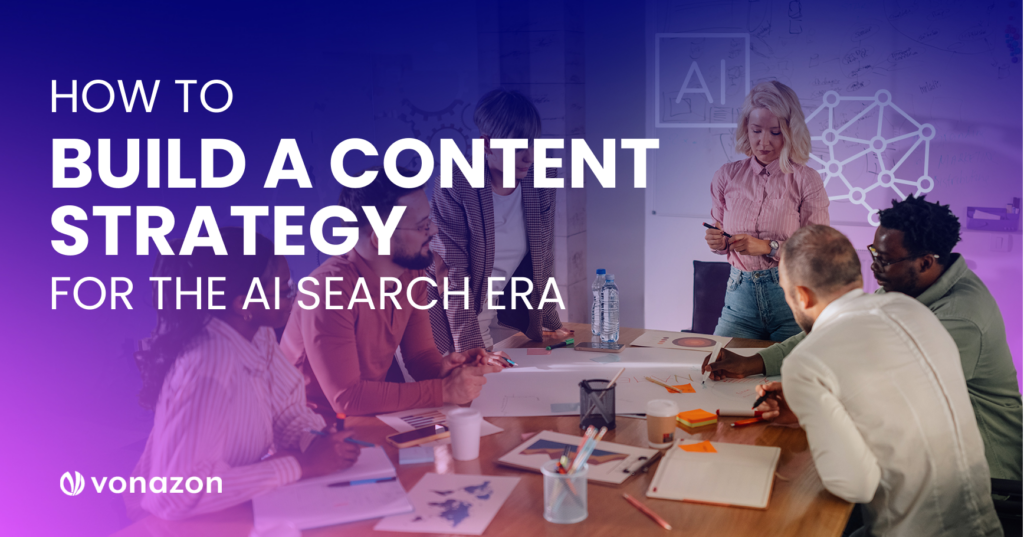How to Build a Content Strategy for the AI Search Era
Rethinking your digital presence when answers are instant and AI never sleeps
Once upon a time, getting found online was a matter of pleasing the algorithm gods: stuff a few keywords, score some backlinks, and maybe, just maybe, land on page one of Google. And for a while, that worked.
But that era? It’s already over.
Today, your buyers are getting answers from AI — not search engines. They’re consulting ChatGPT, tapping Google’s new AI-generated snapshots, and asking Siri or Alexa for product recommendations before they even see a website.
This shift isn’t subtle. It’s seismic. And if your content strategy is still built for a keyword-based crawl-and-rank world, you’re going to be invisible in the places that matter most.
The Great Flattening of Search
What we’re witnessing is the flattening of traditional search hierarchies. Instead of scrolling through pages of results, users now get one — maybe two — succinct, AI-generated answers.
That means the winner takes all.
But here’s the nuance: AI doesn’t “rank” websites the way search engines do. It synthesizes responses based on a massive, implicit trust model. It looks for clarity, structure, topical authority, and reputation — and it’s pulling from across the web to serve the most helpful answer.
So the question isn’t “How do we rank higher?” It’s: How do we become the source AI pulls from?
What Does “AI-Ready” Content Look Like?
Spoiler: it’s not about optimizing for robots. It’s about writing in a way that makes sense to humans — and just so happens to be easily parsed, quoted, and reused by AI systems.
It’s clear.
It’s direct.
It’s trustworthy.
It anticipates real questions.
And it isn’t trying to game anything.
An AI-Era Content Framework (That We Actually Use at Vonazon)
Here’s how we’re helping clients build content strategies that play well with both people and machines without losing voice, value, or velocity.
#1
Prioritize Authority Over Algorithms
AI doesn’t care how many keywords you use. It cares if you know what you’re talking about. Topical depth, subject matter fluency, and audience empathy are your new SEO.
What that looks like:
- Publishing expert-driven content (interviews, case studies, original insights)
- Structuring it with semantic clarity (headings that tell a story)
- Going deep on topics, not just surface-skimming keywords
#2
Design for the Question Economy
When people talk to AI, they don’t search. They ask. So your content has to meet them in that moment.
Translation: Write in a question-and-answer format that mirrors how your audience actually talks. Anticipate their concerns. Reflect their curiosity.
Practical takeaways:
- Add FAQ sections to every service and product page
- Use real customer questions as blog titles
- Format sections like this:
Q: What’s the best CRM for small nonprofits?
A: Something that balances affordability with donor tracking. Think HubSpot, Bloomerang, or Little Green Light.
#3
Build Pillars, Not Piles
Publishing 100 loosely related blog posts is like throwing darts blindfolded. Instead, create topic clusters — a central “pillar” page surrounded by supporting content that all links back to each other.
Why it matters: AI thrives on contextual density. The more you can show subject expertise through content interlinking, the more likely you are to be surfaced as a reliable source.
#4
Clean Up the Mess
Clarity wins. Always.
Use headers. Use bullets. Keep paragraphs short. Write like you speak. Don’t bury your best insight in paragraph five.
(And maybe don’t use words like “synergize.” Ever.)
#5
Make Brand a Ranking Factor
AI doesn’t track your Google Analytics stats — but it does detect brand signals: mentions, reviews, consistency across platforms, third-party validation.
So yes, investing in brand storytelling and trust-building matters more than ever.
Ways to build it:
- Gather and showcase customer reviews (especially on public platforms)
- Be active where your industry congregates (think podcasts, LinkedIn, and niche blogs)
- Get featured, cited, or referenced — AI notices
#6
Write Like a Human (So AI Can Sound Like One)
Here’s a paradox: AI responds best to content written for people. Not bots. Not crawlers. Humans.
So, talk to them. Be helpful, casual, precise. Answer the question. Avoid the corporate fog.
Because when your content reads like it was written by someone who’s been in your customer’s shoes, AI trusts it more. So do people.
#7
Use AI (But Don’t Abdicate to It)
Yes, we use AI to help brainstorm ideas, rework outlines, or summarize complex topics. But we also know that AI is a tool, not a strategy.
The human layer is where nuance lives. It’s where brand voice, emotional intelligence, and storytelling live. Don’t skip it.
#8
Rethink What Success Looks Like
Organic traffic might plateau. Clicks may decline. That doesn’t mean your content isn’t working.
In an AI-first world, brand mentions, quoted passages, and conversion actions carry more weight than raw session counts.
Look deeper. Adjust metrics. Focus on impact, not just impressions.
What Vonazon Is Doing About It
We’re not just watching this shift, we’re building for it. That means:
AI-optimized content audits
FAQ-based rewrites of core service pages
Pillar and cluster content strategies

Conversational copywriting that reflects real user behavior
Brand visibility strategies that actually matter in the AI era
We’re also working with clients to rethink their content teams — building processes that combine human creativity with AI efficiency.

AI is changing the game, but not the goal.
The goal is still to help people. To show up at the right time, with the right message, in the right voice. The platforms may change. The strategy doesn’t have to. It just needs to evolve.
So, if you’re still optimizing for search engines, you’re playing yesterday’s game.
Let’s talk about what tomorrow looks like.






